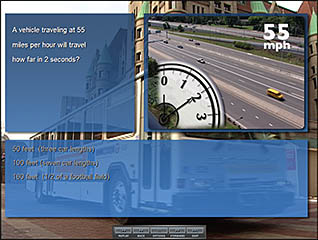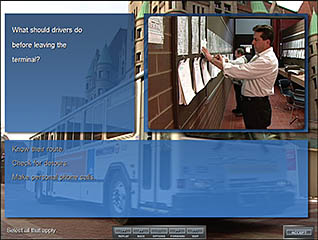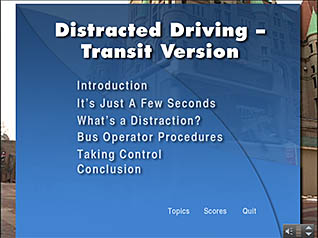Driving: Distracted Driving: At What Cost? Transit Version
- Product ID
- apicddat
- Training Time ?
- 30 to 60 minutes
- Language(s)
- English
- Video Format
- Standard Definition
- Required Plugins
- MasteryNet Player
- Lesson Interactions
- 7
- Quiz Questions
- 17



The human and economic toll of vehicle crashes is staggering, and distracted drivers cause roughly 50 percent of all vehicle accidents. Remaining focused amid the numerous distractions, both inside and outside the vehicle is challenging.
Being attentive at all times is essential. By depicting the tragic results of a real-life distracted driving accident, this training provides the motivation and knowledge to maintain focus while driving. This video training discusses cell phone use, common distractions inside and outside a vehicle, and the effects of multiple distractions. Topics unique to the transit industry, such as responding to passenger disturbances, pre-trip vehicle adjustments, planning your route, and the use of two-way radios and mobile data terminal are discussed.
In the transit industry you must contend with more distractions than the average driver. Use this online training to understand the hazards of distracted driving and learn how to stay focused while on the road.
![]() This course is in the Advantage™ format, to read about Advantage™ features click here.
This course is in the Advantage™ format, to read about Advantage™ features click here.



- Rich multimedia presentation with interactions and quiz
- Print certificate and wallet card
- You have 30 days to complete the course
Drivers in the public transit industry
-
Introduction to Distracted Driving
- A distracted driving crash
- The toll from distracted driving
-
The Effects Of Being Distracted
- Distance traveled in two seconds at 30 mph
- Distance traveled in two seconds at 55 mph
- Cell phone use and loss of peripheral vision
- Distractions and drifting from your driving lane
-
What Is A Distraction?
- Common distractions
- Cell phone use
- Multiple distractions
-
Distracted Driving Collision
- The crash and the investigation
- Actions that could have prevented the collision
-
Bus Operator Procedures
- What to do before leaving the terminal
- Radio procedures
- When to use the data terminal
-
Taking Control
- Cause of most distractions
- Ignoring uncontrollable distractions
- Distractions from rowdy kids
- Options for safely managing a fight
- Making adjustments before driving
- Driving in unfamiliar settings
-
Conclusion
- Learning from a tragic true story
-
Prevent harmful effects of distractions on driver attention and reaction time.
- Describe how far a vehicle travels in 2 seconds at 30 & 55 mph.
- Explain how cell phone use reduces distant and peripheral vision.
- Describe how distractions reduce reaction time
-
Avoid activities that distract our attention from driving.
- Recognize common activities that can distract us from our driving.
- Identify distractions that contributed to specific traffic accidents
-
Practice procedures that help bus operators avoid driving distractions.
- Know route and detours before leaving the garage.
- Avoid using radio or data terminal while the bus is in motion.
-
Safely avoid or manage driving distractions.
- Recognize that our actions cause most distractions.
- Describe how to ignore distractions we can't control or avoid.
- Explain vehicle adjustments to make before driving that reduce distractions.
- Identify methods to avoid distraction when driving in unfamiliar settings.
- Describe how to deal with fights and rowdy passengers.
© Mastery Technologies, Inc.


